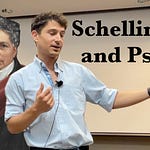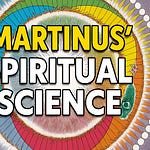The conversation above occurred earlier today at the end of a two-day conference I cohosted with Spyridon Koutroufinis focused on the revitalization of biophilosophy. You can learn more about it at the Center for Process Studies website. You can find a YouTube playlist of all the talks at this link.
Two days of phenomenal presentations of ideas that push at the paradigmatic edges of the life sciences left me feeling nourished. But there were also a few conceptual tensions that I felt called for our collective attention. Having listened to talks ranging from biosemiotics to process metaphysics, from computational biology to philosophical anthropology, I began with two particular pressure points that stood out to me.
The first tension emerged most directly in the contrasting visions of Terrence Deacon and Michael Levin. While Mike extends cognition down to thermostats and up to Platonic forms, Terry insists on fundamental differences between computation and biological morphogenesis. I don’t think this is merely semantic. It decides how we understand the relationship between matter, life, and mind.
The second tension concerned the perennial problem of individuality versus relationality. Throughout the conference, we’d wrestled with the ethics of viral pandemics, von Uexküll’s enclosed umwelt, autopoietic operational closure, Canguilhem’s vitalism, Simondon’s transductive relations, Aristotle’s entelechy, Bergson’s virtual, and more. Can we maintain individual autonomy while acknowledging the profound ways organisms interpenetrate and shape each other? Autopoiesis or sympoiesis? Who decides?
Another question that quickly rose to the surface was how to think about generative AI technologies. The distinction between simulation and realization of conscious intelligence isn’t merely an academic issue. It has immediate implications for cultural life, and how we relate to increasingly sophisticated designed-for-profit generative models.
People are already beginning to attribute not just artificial intelligence but conscious sentience and personhood to their instance of ChatGPT. If we follow one interpretation of Mike Levin’s position—potentially canceling the simulation/realization distinction—might we invite people to relate to their machines as individual souls, persons deserving of rights? Is the genie already out of the lantern? This is concerning...
I offered a Platonic perspective on LLMs, suggesting that we should approach these technologies the way Plato approached alphabetic writing: critical yet participatory. Yes, they’re dangerous tools. Yes, they can have distorting effects. But we can also use them skillfully, so long as we remain aware of how they are shaping us.
LLMs mark another major shift in the long coevolution of humans and our media technologies, following on the heals of speech, writing, and alphabets. Extending Terry Deacon’s work on how language has rewired the human brain, I noted that these tools are already reshaping our cognition and social imaginaries in ways we are only just beginning to grasp. We’re focused on how LLMs hallucinate, but maybe we should pay more attention to the ways we are being encouraged to hallucinate about them. The idea of “artificial general intelligence” or “conscious machines” is more an advertising strategy than a near term engineering reality.
I do appreciate and agree with Mike’s point that there are minds all around us that we’re failing to notice. And that this deficit lies in our own lack of sensitivity, not in theirs. But for precisely this reason, how we decide in any given case may not just be a matter of empirical tests but of our own psychological dispositions.
As a process-relational panexperientialist, I see both mind and aim as existing on a continuum, from the least action principles governing physical processes all the way up through human creativity and moral intuition, perhaps even extending into higher forms of intelligence (artificial, alien, or angelic) that our egocentric, humanistic biases prevent us from acknowledging.
This came up in our afternoon conversation when I mentioned Whitehead’s distinction between the “subjective aims” of all actual entities—stretching all the way down into the quantum structure of the physical world (and it’s worth noting here that quantum reality isn’t just “small” or “large,” but rather something profoundly nonlocal and prespatial)—and the biological agency that emerges at the level of what he calls “living societies” or organized historical routes of actual entities.
There are two levels here. On one level, we have the actual entity with its subjective aim: this is a metaphysical category in Whitehead’s scheme. On another level, we have societies, or patterns of enduring organization, whether physical or biological: this is a cosmological category. What this means is that particular forms of agency or functionality that arise amidst the enduring structures of the physical world must be seen as contingent, historically emergent patterns. Even stars and atoms are products of cosmic evolution. Not even physics can escape the acid of evolutionary thinking.
Biological agency, then, isn’t something wholly separate from the rest of physical nature. It emerges later in the evolutionary process as a new threshold of autonomy—a novel “bid for freedom” (Whitehead’s phrase) relative to the spatial and temporal environment.
“The problem to be solved is that of a certain originality in the response of a cell to external stimulus. The theory of an enduring entity with its inherited mentality gives us a reason why this mentality should be swayed by its own past. We ask for something original at the moment, and we are provided with a reason for limiting originality. Life is a bid for freedom: an enduring entity binds any one of its occasions to the line of its ancestry. The doctrine of the enduring soul with its permanent characteristics is exactly the irrelevant answer to the problem which life presents. That problem is, How can there be originality? And the answer explains how the soul need be no more original than a stone. … What has to be explained is originality of response to stimulus. This amounts to the doctrine that an organism is ‘alive’ when in some measure its reactions are inexplicable by any tradition of pure physical inheritance.
Explanation by ‘tradition’ is merely another phraseology for explanation by ‘efficient cause.’ We require explanation by ‘final cause.’ Thus a single occasion is alive when the subjective aim which determines its process of concrescence has introduced a novelty of definiteness not to be found in the inherited data of its primary phase. The novelty is introduced conceptually and disturbs the inherited ‘responsive’ adjustment of subjective forms. It alters the ‘values,’ in the artist’s sense of that term. …
The characteristic of life is reaction adapted to the capture of intensity, under a large variety of circumstances. But the reaction is dictated by the present and not by the past. It is the clutch at vivid immediacy.”
(Process and Reality, 104-105)
But we need to be very cautious in how we try to distinguish an organism from its environment. Is there really any rational or scientific way to draw that line cleanly? If some form of special agency emerges with living cells, the question becomes: emerges from what? Was there ever really such a thing as “dead” matter? I don’t think so. In fact, it seems more likely that what we now call “dead” matter—much of the mineral content around the Earth’s surface—isn’t some primordial substrate that life arose from, but is actually an excretion of life itself.
Whatever agency is, it is not simply a property of isolated bodies. It’s a relational achievement involving the whole of cosmogenesis. Whitehead affirms that there is a more basic form of aim that precedes the conscious agency of animals, a form of being and becoming as a subject-superject, enjoying one’s existence and aiming to enhance it. Vibrating energy is not just mechanical motion through empty space. Nor is evolution merely random variation and natural selection. Variation is never entirely mindless. Long before humans mathematically decoded its waveforms, electromagnetic vibration was already an aesthetic phenomenon, a natural expression of harmonic rhythm. Energy is the transmission of pulses of emotion. Agency, we could say, is what happens when energy turns itself inside out. But energy could never give rise to living organisms unless it was already aiming at aesthetic enhancement from “the beginning” (“beginning” here really signals eternity rather than an origin point in linear time; and eternity is not somewhere else out there but only ever right here and now).
Throughout the discussion, I tried to identify connections and resonances between different perspectives. When Tim Feiten explored the ethics of closed versus open umwelts, I immediately thought of Katherine Peil Kauffman’s presentation on emotion as the bridge enabling genuine intersubjective resonance. This isn’t just metaphorical: if cells equalize their voltages when they touch (as Mike Levin showed), perhaps emotional resonance literally opens our otherwise private experiential worlds to each other.
We had an extended discussion about Peirce’s categories—firstness, secondness, and thirdness—leading us into fundamental questions about explanation and origin. Is there an irreducible co-extensiveness of all three categories, such that thirdness is always already present “at the beginning” (another way of saying, with Whitehead, that aim or minimal mentality is cosmic in extent and not just emergent with biological organisms); or do we need to think genesis to its limit by acknowledging the ordinality implicit in any developmental scheme, with the firstness of variation being given its due?
My own position is that variation is already be telically tilted, not randomly dispersed. This doesn’t require an external designer but just acknowledges that Creativity has an inherent tendency to condition itself. My question for the group was whether the existence of biological agency requires a cosmic Eros or can emerge from truly undirected variation under brute natural selection.
I share
’s resistance to making any particular thirdness primordial. This just serves to block inquiry with unexplained explainers. Yet I still myself drawn to Whitehead’s notion that what is metaphysically contingent (God as the first accident of Creativity) can also be categorically necessary. Whitehead intends his God concept to function as a maximally generic potential for organization without determining the specific forms that organizational potency takes.By the end of this conversation, I felt we had not resolved but intensified these fundamental tensions. The discussion revealed biophilosophy as a form of transdisciplinary research operating at the molten intersections of empirical science and philosophical speculation, technical precision and ethical concern. I invited participants to continue the shared inquiry at the International Whitehead Conference next summer in Carbondale, Illinois, where we’ll have another biophilosophy session.
The path forward isn’t to resolve the tensions but to think with and through them, maintaining conceptual precision while embracing experimental openness (including experiments on language itself). The life of thought lurks in these very tensions!
As hosts of life ourselves, we’re not external observers but examples of the very processes we are seeking to understand. This onto-epistemic participatory situation is precisely what I sought to address in my conference talk yesterday. More on that soon!
This closing conversation reminded me why biophilosophy matters: it’s where our deepest questions about the nature of life meet our most pressing concerns about the future we’re creating together on this fragile planet.












Share this post